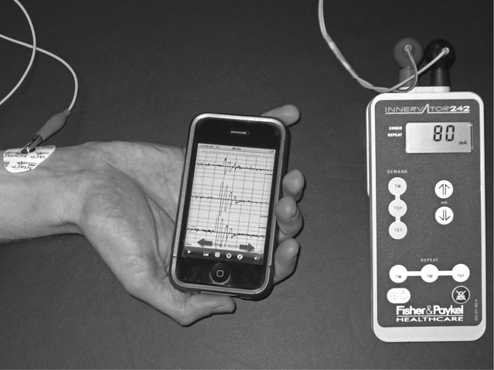Unusual utilisation of mobile technology in medicine
Rafsan Halim1
1Multimedia & News Editor. Journal of Mobile Technology in Medicine, Australia
Corresponding Author: raffy@journalmtm.com
Journal MTM 2:2:1-2, 2013
http://dx.doi.org/10.7309/jmtm.2.1.1
The popularity of mobile technology has grown rapidly over the last few years1 and the integration of mHealth is transitioning from a curiosity to an accepted part of health-care delivery. With the growing number of mHealth applications, systematic reviews have highlighted limitations in evidence for their benefits2. Despite the paucity of high-quality evidence, the unpublished and grey literature is littered with excellent examples of innovative applications and implementations of mHealth that may benefit patients and be of interest for future research. This has spurred interest from developers to think “outside the box” when trying to solve healthcare issues. We bring to the reader’s attention some of these ‘unusual’ applications and the exciting potential offered by new developments.
With iPhone adoption being as high as 59% amongst anaesthetists3, it is a field that ripe for interesting applications of mobile technology. Like other specialties, there are an extensive number of apps and attachable peripherals for the device3–5 . One particularly innovative use of the device involves the utility of the accelerometer built into the phone6. Reversal from neuromuscular blockade is best measured with a Train-of-four ratio technique, which requires a nerve stimulator and a measurement device for the force generated, such as an accelerometer7. The nerve stimulator causes a short burst of muscle twitches the force of which is related to the degree of muscle paralysis7. Whilst nerve stimulators are easily accessible, accelerometers are generally more difficult to access in the clinical setting. By combining the built in accelerometer in the iPhone along with the iSeismology app (Figure 1), clinicians have developed an alternative way of measuring the aforementioned ratio6.

Figure 1: Nerve stimulator and iSeismology app being used to check Train of Four ratio (6)
Recent interest in augmented reality (AR) technology have resulted in several novel applications. DoctorMole™ is a dermatology smartphone app that aims to aid the assessment of skin moles and diagnosing malignancies. The app can assess a mole through the phones camera and analyse the image via an algorithm for symmetry, border, colour & diameter to estimate the risk of a suspicious lesion being malignant8. Whilst such applications have been shown to have varying degrees of accuracy, potentially resulting in incorrect diagnoses9, it serves as an example for the future potential for AR use.
AR is also being utilised for medical education. The newly unveiled Google Glass™ has featured prominently in technology news and has now been utilised during surgery. A percutaneous endoscopic gastronomy was performed by a surgeon with the live video feed used to educate doctors in training on how to perform the procedure. The device allowed for an “operator view” and the sharing of the endoscopic view as well to enable a better understanding of the procedure for the trainee10.
One of the most unusual applications that has been reported involves the development of highly specialised patient slippers. Termed “smart slippers,” these devices use pressure sensors to analyse gait and identify possible medical issues or high falls risk. The device would then be able to alert the patient’s clinician of such risks or falls via a transmitter11.
These imaginative and unusual applications of mobile technology highlight the potential for further development in the field of mHealth. Furthermore, they help spark the creativity that is essential to such novel implementations of mHealth that will one day become mainstream. We recognise that there will be an inherent limitation in the amount of clinical data available with such developments in the early phases of development, however providing robust clinical data to support the use of any medical technology should be the ultimate endpoint of development. Here at the Journal of Mobile technology in Medicine, we encourage sharing of these new developments with other mHealth researchers through our news section, and eventually with original research data published in the journal.
References
1. Ozdalga E, Ozdalga A, Ahuja N. The smartphone in medicine: a review of current and potential use among physicians and students. J Med Internet Res 2012;14:e128. ![]()
2. Free C, Phillips G, Galli L, et al. The Effectiveness of Mobile-Health Technology-Based Health Behaviour Change or Disease Management Interventions for Health Care Consumers: A Systematic Review. PLoS Med 2013;10:e1001362. ![]()
3. Dasari KB, White SM, Pateman J. Survey of iPhone usage among anaesthetists in England. Anaesthesia 2011;66:630-1. ![]()
4. Cabalag C. The (Ultra)sound of Things to Come. JournalMTM 2012;1:5-7. ![]()
5. Mosa ASM, Yoo I, Sheets L. A Systematic Review of Healthcare Applications for Smartphones. BMC Med Inform Decis Mak 2012;12:67. ![]()
6. Langford R.iPhone for monitoring neuromuscular function. Anaesthesia 2012;67:552-3. ![]()
7. Pharmacology and Physiology in Anesthetic Practice 4(null) ed. Philadelphia: Lippincott Williams & Wilkins.
8. Banova B. The Future of Mobile Technology in Medicine: Innovative Medical Apps. medcitynews.com.2013; http://medcitynews.com/2013/04/the-future-of-mobile-technology-in-medicine-innovative-medical-apps/ (accessed 5 Jun2013).
9. Wolf JA, Moreau JF, Akilov O, et al. Diagnostic inaccuracy of smartphone applications for melanoma detection. JAMA Dermatol 2013;149:422-6. ![]()
10. Grossmann R. OK Glass: Hand me the Scalpel Please … Google Glass During Surgery. @ZGJR Blog. 2013; http://rgrosssz.wordpress.com/2013/06/20/ok-glass-pass-me-the-scalpel-please-googleglass-during-surgery/ (accessed 21 Jun2013).
11. Smar Slippers. Foot-Signature Telemetry in insole to detect or even provent falls. At&T Innovation Space. 2009; http://www.attinnovationspace.com/innovation/story/a7619600 (accessed 20 Jun2013).

